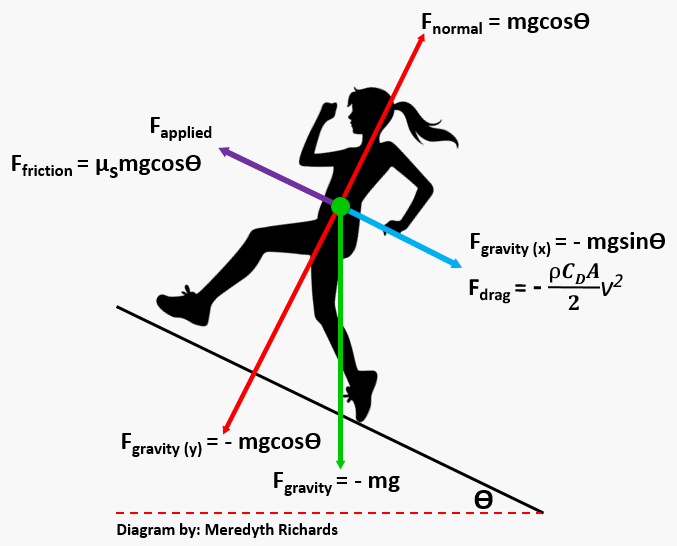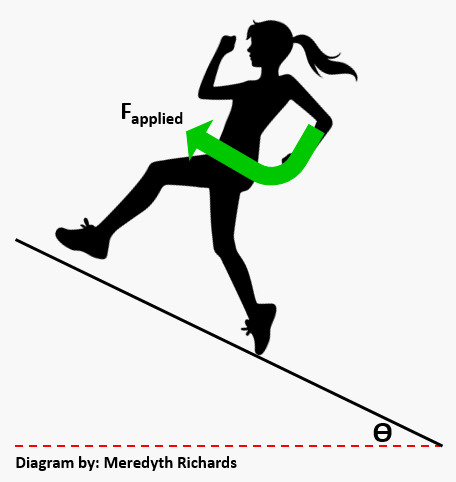|
Lean
In
The true test of Equinox mettle begins at the base
of Ester Dome. Five solid miles of straight uphill
are followed by a brief respite of three steeply
rolling hills over which an additional 600 feet of
climbing is required. In reality, the four-mile
"out-and-back" is not a respite at all.
To most
efficiently tackle this grueling portion of the
course, it helps to consider the force diagram.

The
forces acting against the runner's progress up the
hill are given negative signs whereas those helping
her reach the summit are positives. Therefore, to
move forward, she must apply a force that meets this
criteria:

As our own experience with inclined surfaces
suggests, more force must be supplied to travel up a
hill as the angle of the hill relative to the
horizontal increases. In this scenario, not only
does the x-component of the gravitational force
increase (sin
approaches 1) but the frictional force helping
uphill movement decreases (cos
approaches 0). While the y-component of the
gravitation force does decrease with a steeper hill,
it is not sufficient to overcome the gain in Fgravity(x)
and loss in Ffriction. The only force not
directly dependent upon the gradient
is the drag force. However, as a function of
velocity, which tends to decrease while traveling up
inclines, Fdrag nevertheless indirectly
depends upon the hill.
As quantities strictly connected to theta, runners
are stuck with the unpleasant forces that result
from the geometry of any given hill. Because their
desired endpoint is in the opposite direction (up)
of the gravitational force pulling them towards the
Earth (down), they must do work - in the Equinox, a
lot of work - to get up that hill! But by leaning*
"into" the hill, shifting the center of mass as far
above the front foot as possible, the gravitational
force is re-positioned. While the force does not
diappear or lessen, when coupled with a planted foot
that functions as a fulcrum, the runner's core acts
as a forward-rotating load with angular momentum.
Although performing this maneuver on an uphill is
easier than on a downhill or a flat road (what
professional runners attempt), it is still difficult
and requires deliberate practice. Even when done
perfectly, the extra jolt it theoretically provides
is still overwhelmed by the gains and losses of
other forces. Yes, it is easier to conquer hills
with a forward lean than with a backward lean or
neutral body position; no, it is still not easy.
Bear
Arms
To help
preserve tired legs for the remainder of the
race, arms are an important source of applied force
in the Equinox's uphill climbs. Just as they did on
rooty and winding trails, swinging arms do still supply
the offsetting torque required to maintain
directional control. With the more stable footing
and straighter uphill route though, arms can more
readily move in a purely forward direction and
supplement the launching force provided by the
runner's legs.

Maximum force from arm movements is achieved when
the shoulders are dropped and the elbow is bent
around 90
degrees. Because the arm behaves as a
pendulum**, the largest velocity for a given mass
exists when the length of the pendulum (i.e.
distance between shoulder and elbow) is the
smallest. When the elbow is held at a constant angle
and driven as far back and then forward as possible,
the system/arm has the most potential and kinetic
energy. As the kinetic energy increases during
the pendulum's downswing, a force is applied by the
runner in the direction of motion and positive work
is performed, helping them up the hill. The repeated
arm pumping required to produce this additional
applied force is energy intensive and therefore not
an efficient technique for running long
distances on flat surfaces. For
hills, however, arm pumping economizes
the extra energy inherently required
during climbs by shifting some of the demand from
the legs.
*Biomechanically, it is critical to lean with the
hips not bend at the waist. This project is about
physics, though.
**Technically, this is a double pendulum. Assuming
the angle between the lower and upper arm remains
constant, an analogy with a single pendulum seems
more accurate.
|





